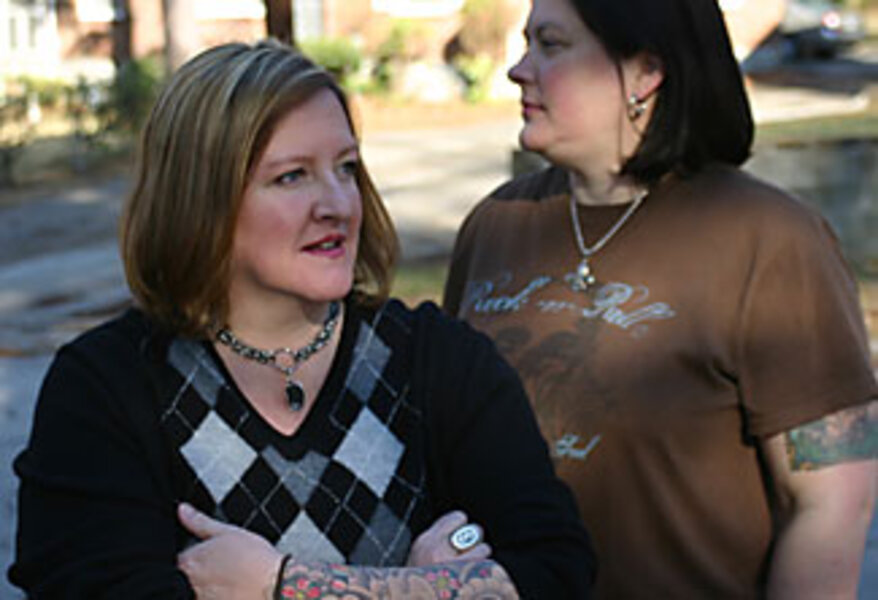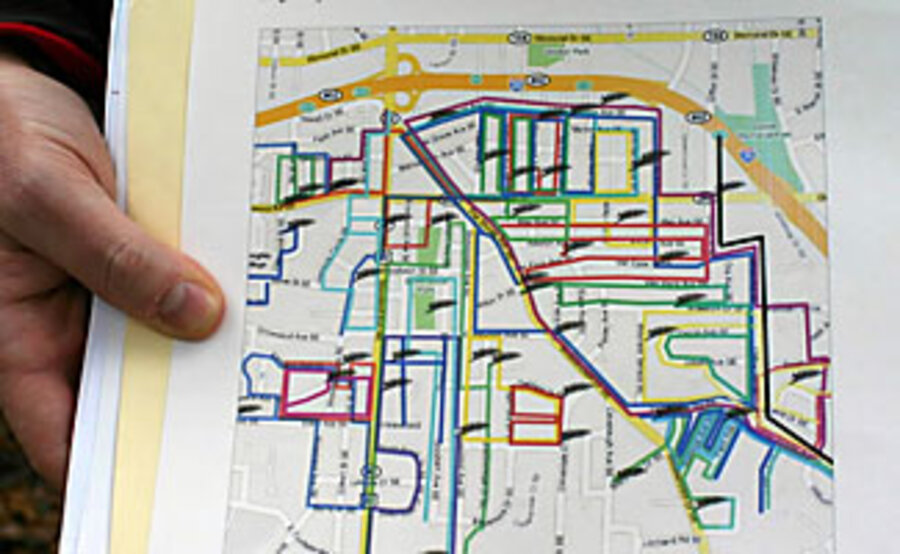As property crimes increase, more neighbors are on patrol
| Atlanta
It's not unusual for Jennifer Litkowiec to have problems with her husband's off-the-wall ideas, but this one took the cake.
Hispanic gangs had seeped into the couple's quiet corner of the working-class town of Cudahy, Wis., just south of Milwaukee, stealing garage door openers and returning later to score the contents.
So what was Jason Litkowiec's plan? Shine a light on the night. "I finally had enough," he says.
Against his wife's loud protestations, the young steamfitter joined a dozen other neighborhood men and set up the Rosewood night patrol.
Armed with nothing but flashlights and cellphones, the group followed suspicious cars and even set up an impromptu sting when a neighbor left town and forgot to close his garage door. They called in police to arrest the suspects after a brief chase.
High foreclosure rates, a spike in brazen break-ins, and slashed police budgets are causing turmoil in America's transitioning urban communities, auguring what Atlanta anticrime activist Larry Ely calls an "urban war."
So far, this is a largely unarmed conflict defined by nighttime jogger patrols with flashing headlamps, unofficial block patrols with cop-like "beats," and neighborhood all-Twitter alarms – short text messages dubbed "BOLO" or "be on the lookout" when something potentially dangerous or illegal happens.
A sense of humor helps. Some who take part have signed on to the "World Superhero Registry," an online outfit where a member must be one "who does good deeds or fights crime while in costume."
But like other historical flash points, when the public becomes personally involved in crime fighting, vigilantism becomes a threat, experts say, especially if government appears powerless.
"When you go broke, be creative. Outsource criminal justice back to the people," says Peter Scharf, a criminologist at Tulane University in New Orleans. "When you go through a very chaotic period with crime, people are going to become more innovative."
Hard numbers on the rise in amateur crime fighters don't exist, but policing experts say the trend is noticeable. At the National Sheriffs Association (NSA), which runs some 26,000 Neighborhood Watch groups, activity has risen to nearly the levels of the winter of 2001, following 9/11.
NSA crime prevention specialist Robbie Woodson links the uptick directly to the Congressional decision in 2007 to cut community policing grants by 68 percent, much of which had been aimed at low-level crime in transitional neighborhoods. Ms. Woodson says President Obama's inaugural call for "a new era of responsibility" took direct aim at what she sees as a widening gap – both perceived and real – between criminal activity and the ability of police to control it.
"It's an absolute perfect storm," says Woodson. "[Federal policing grants] were cut before the economic crisis, which is just now playing out on the law enforcement front. And now you have people being laid off, and some of those people are going to start stealing in a variety of different ways."
Rising property crimes a factor
Though violent crimes are down across the nation, property crimes by many accounts are rising. (FBI crime figures for 2008 won't be available until fall.) Transitional neighborhoods around major urban centers are particularly prone to the cause-and-effect between rising crime and community patrols, as national migration figures slow and more and more Americans hunker down.
"When we retreat, we feel vulnerable," says Gregg Barak, a criminologist at Eastern Michigan University in Ypsilanti.
What seems to have sparked many groups isn't just low level crime, but high profile incidents and brazen tactics like bashing in front doors to get at large flat-screen TVs. The murder in Atlanta of a bartender by four armed bandits on Jan. 7 resulted in the creation of a group called Atlantans Together Against Crime (ATAC). In the span of two weeks, the group had almost 5,000 members on Facebook.
"I'm not sure the total level of crime is changing significantly, and the conveyor belt that produces crime is more or less the same," says Robert Friedmann, a criminologist at Georgia State University. "The problem comes when you have a human story that suddenly has a new twist."
Two years ago, Lisa Cater was part of a real estate boomlet in East Atlanta Village, a community about three miles from downtown, as mostly white suburbanites flooded back to the city. But now that movement has largely stopped, many houses are empty, and criminals have become more brazen and open, she says.
"This is the worst I've ever seen it," she says, describing what she calls a "property-driven turf war."
With her partner, Maria Midboe, Ms. Cater patrols her street in an imposing black Jeep, often using a high-power spotlight to shine on suspicious characters.
"The only way we can make a difference is to take personal responsibility and do something about it," she says.
Amateur crime fighters like Cater can be found across the nation.
In Plano, Texas, residents created a watch group to look after vacant and abandoned homes. In New Orleans, groups like Silence is Violence are using Twitter alarms and cell phone messages to fight that city's violent crime wave.
Clayton County, Ga., is one of a growing number of police departments putting arrest and warrant information online in map form to give residents a sense of who has had previous run-ins with the law.
And though Twitter alarms and other tech-savvy warning systems can sometimes ratchet up the perception of crime rates, they're also being used effectively: An Atlanta break-in captured by home cameras and then put up on YouTube helped police catch several suspects last month.
"Just by the nature of crime trends in the metropolitan environment and this financial environment, it's difficult to put the resources on the street that we may have had in the 1980s," says Cudahy Police Chief Tom Poellot. "Police can't do this alone."
Citizen awareness is part of the foundation of modern policing, born when 19th century London bobbies used whistles to call in civilian backup.
But community fear has in the past turned to violence in a country where vigilantism has sometimes flourished.
The Nation magazine recently reported that after hurricane Katrina, vigilantes killed several black men for simply walking through a neighborhood. Several registered sex offenders have also been killed. Citizen patrols became a controversy in New Haven, Conn., in 2007 when the Edgewood Park Defense Patrol included some armed with licensed firearms.
"If it's largely white citizen groups trying to protect new turf, you run the risk of creating flash points," says Stan Stojkovic, dean of the Helen Bader School of Social Welfare at the University of Wisconsin, Milwaukee. "But to me, this is a much different kind of situation. There's hope in this kind of thing, as long as it evolves into ... a form of integration."
The power of "Hey!"
That's what Lewis Cartee is careful to address with the more gung-ho members of his block patrol group in East Atlanta, known as Safe Atlanta for Everyone (SAFE). He calls the group "a glorified neighborhood watch" where he uses Google maps to chart out "beats" for some 40 residents. He says he stresses what he calls "the power of 'Hey.'"
"You've got to go meet people, because the guy down the street you're suspicious of could be a good guy, and you run the risk of putting that guy off," says Mr. Cartee. "No way do you want that patrol being seen as us versus them."
Done inclusively, neighborhood patrols can be a powerful deterrent, says Rufus Terrill, an Atlanta mayoral candidate.
"Bad guys don't like to be seen doing things," says Mr. Terrill. "They don't want people's eyes on them. They fear that as much as a gun."
In Cudahy, it took Litkowiec and his band of civilian crime fighters a mere three weeks to effectively deter the garage robbers in the Rosewood neighborhood.
"We basically figured we should be able to outsmart some common thieves," says Litkowiec, who last week was handily elected to the city council on an anti-crime platform.







